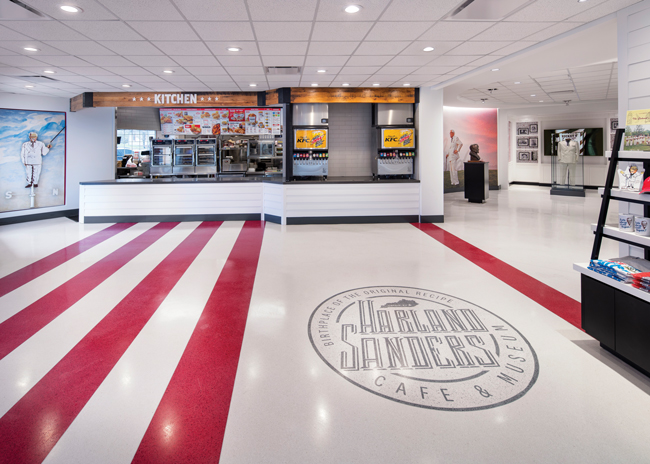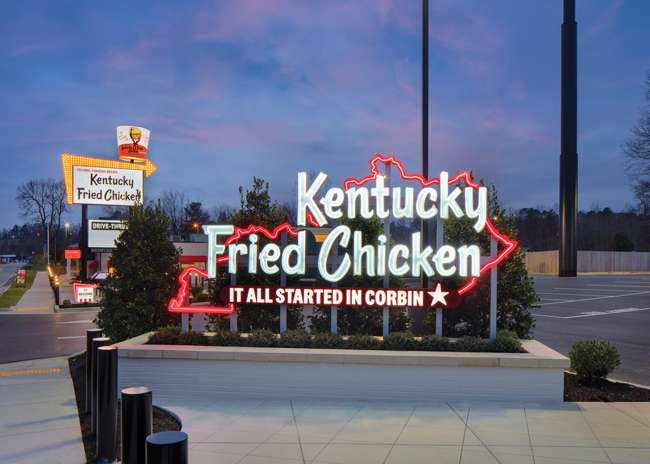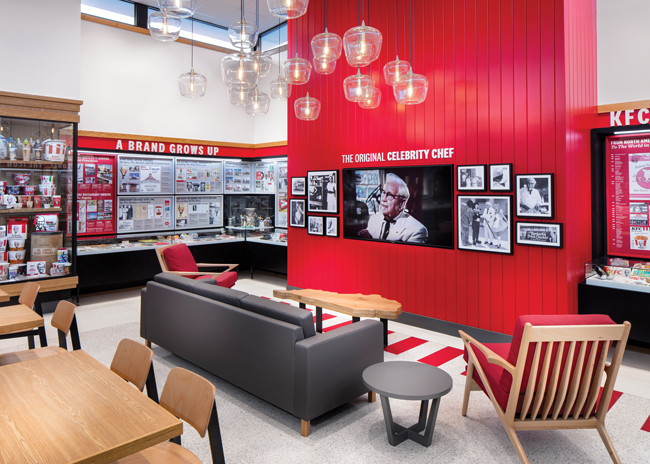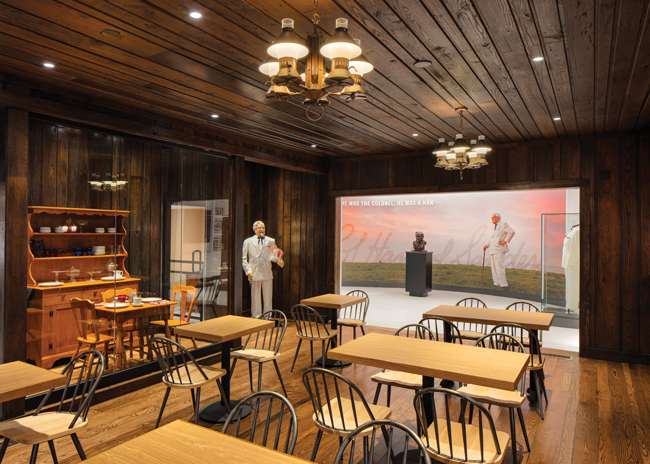KFC got its start in Corbin, Kentucky. The Harland Sanders Café & Museum in the location of that original restaurant has been redesigned to better celebrate the chain’s founder.
The word “iconic” gets tossed around a lot in the restaurant industry. Every chain with more than a couple of decades of history will talk about its iconic logo or its iconic mascot. There’s nothing wrong with this, as some legends are local, but it’s mostly marketing. There simply are not that many true icons among chain restaurants.
Colonel Sanders — the founder of KFC (nee Kentucky Fried Chicken), legendary developer of the secret blend of 11 herbs and spices, the man in the famous white suit — is iconic.
 The Colonel’s Sitting Room is the most museum-like area in the operation. The brick wall in the back was part of Sanders’ original restaurant and was moved to this location to keep a connection with the chain’s history. Images courtesy of Harland Sanders Café & Museum
The Colonel’s Sitting Room is the most museum-like area in the operation. The brick wall in the back was part of Sanders’ original restaurant and was moved to this location to keep a connection with the chain’s history. Images courtesy of Harland Sanders Café & Museum
The Colonel’s roots trace back to Corbin, Ky., where Harland Sanders first opened a gas station in the 1930s. He eventually expanded that business into a hotel and restaurant on the same small campus. That’s where Sanders started offering fried chicken and where he perfected his famous recipe.
Today, that campus is home to the Harland Sanders Café and Museum. Featuring a KFC franchise, Sanders Café is owned and Operated by JRN Inc., one of the country’s largest multi-unit, multiconcept franchise operators and a decades-long KFC operator.
This restaurant is a centerpiece of KFC lore and, as proven by its spot on the National Register of Historic Places, a location of genuine and
widespread interest.
For years, though, the space itself didn’t quite match its importance.
“The story that was being told was not necessarily an elevated one,” says Garrett Rice, a graphic designer with architecture and interior design firm Nelson Worldwide. “It was kind of a hodgepodge of artifacts loosely [displayed] in some old jewelry cases. It was a mecca for the brand, but the experience itself did not live up to the heritage of the place.”
Nelson has long had a relationship with KFC and many of its franchisees. In fact, Nelson created KFC’s current prototype design and has completed work on other high-profile KFC locations. So, when JRN decided it was time for the Sanders Café’s design to match the location’s importance, Nelson was the clear choice.
 A functioning KFC location, the Sanders Café & Museum is connected through brand colors to the larger chain.
A functioning KFC location, the Sanders Café & Museum is connected through brand colors to the larger chain.
Choosing Harland
In creating a space to better celebrate Harland Sanders’ life, Nelson had an outstanding partner in JRN, says Rice. One huge resource was Steve Dearing, the franchisee’s senior vice president of design and construction. A JRN employee for more than 50 years, Dearing knew The Colonel personally and played an important role in shaping and guiding this project.
According to Rice there was never much doubt about what, exactly, the restaurant would focus on. Though KFC has other elements that are celebrated in this store — the 11 herbs and spices and the famous bucket, for instance — it was only natural for this space to be built around Harland Sanders, the man.
“There is such a rich story to tell [here] that no other KFC location can claim. This exact location was where The Colonel himself used to walk from his house along a gravel path to his café where he perfected his recipe and started serving his now world-famous chicken. The path is still there today, and guests can walk along it and share in that heritage.”
Another big question, and one not so easily solved, was how to incorporate the existing structure and design into this redesigned space. Tearing the building down and starting from scratch was never on the table, of course. That would literally be tearing down the brand’s history. But the designers needed a framework for how to think about the design elements already in place. In the end, the team opted for a “sympathetic addition,” Rice says. The new design would seek to honor what was in place and add period-appropriate pieces that would work in tandem with those heritage items.
Finally, while the designers wanted to elevate the space, they still had to make it look like a KFC. This was achieved though the usual elements of typography and brand colors.
Notably, the Sanders-focused theme also helps connect this restaurant to the brand as a whole. The standard KFC design created by Nelson is dubbed “The American Showman.” It features images of Sanders and bills him as “the original celebrity chef.” The connection between these elements and the Harland Sanders Café and Museum is clear.
 The Sanders Café is designed to be eye-catching from down the road.
The Sanders Café is designed to be eye-catching from down the road.
See the Signs
Sanders Café is designed to be eye-catching from far down the road. While every operation wants to get noticed, visibility is especially important for this operation. When the cafe first opened its doors decades ago, it was located on a main road in Corbin. Thanks to the construction of Interstate 75 in the 1960s, that road is now off the beaten path. To find the restaurant, “you have to meander your way there,” says Rice.
The designers, then, wanted to make it easier for fried chicken pilgrims to find Sanders Café, and to add to their excitement when they finally draw near. They achieved this with a large, unmissable sign that’s a clear throwback to the early days of KFC. It features a stylized blinking arrow and a rotating bucket made to look like the original KFC bucket of chicken.
That’s not the only piece of exterior design that contributes to the Sanders Café experience. In a nod to Harland Sanders’ gas station, the design team added a set of period-appropriate gas pumps, accompanied by a small timeline explaining the evolution of the space. There’s also a large neon sign with an outline of the Commonwealth of Kentucky and the full Kentucky Fried Chicken name in lights.

This sign, in particular, is the first of many social-media friendly moments at Sanders Café. It also, notably, uses the chain’s full original name. “This is not an official mantra, but they said they do have ‘pride in fried,’” says Rice. “They are still very much KFC, but because this is rooted in where it all started, we went back to Kentucky Fried Chicken as the overall statement of what we’re all about here.”
Architecturally, the cafe building itself doesn’t look anything like a typical fast-food restaurant. That’s to be expected for a structure that dates to the first half of the 20th century. Instead, it has a Tudor-style exterior with multiple peaks — some original, some added in earlier renovations.
The major architectural changes in this redesign included an addition that houses many brand artifacts as well as a new vestibule entryway that “gives guests a moment of pause and celebrated entry,” says Rice.
A Piece of Chicken, A Piece of History
Past the vestibule, visitors will find a red and off-white terrazzo floor, with an inlaid Harland Sanders Café & Museum logo made of terrazzo itself. Since this is a working restaurant, the floor’s design leads guests past a small merchandising/souvenir shelving unit to the kitchen and POS station, where they can place their orders.
The operation’s first real museum experience is just off to the right of the POS station. Here guests will find a display that proclaims that “Before [Sanders] was The Colonel, he was a man.” Here guests can find a bust of The Colonel, one of his famous white suits, and a history of Sanders’ life before KFC.
 The Colonel’s Spice Room is the design team’s imagined space where Harland Sanders experimented with herbs and spices. A wall installation is made of jars of seasonings.“The alcove is a representation of his timeline and the story of how he got to be where he ended up. He started franchising KFC in his sixties. He was already an older man. He lived a lot of life before he got here,” says Rice.
The Colonel’s Spice Room is the design team’s imagined space where Harland Sanders experimented with herbs and spices. A wall installation is made of jars of seasonings.“The alcove is a representation of his timeline and the story of how he got to be where he ended up. He started franchising KFC in his sixties. He was already an older man. He lived a lot of life before he got here,” says Rice.
While this is a new feature of the cafe/museum, it leads to a dining area that features not just history lessons, but actual historical elements.
This dining room is clad nearly top to bottom in wormy chestnut wood. While that material is extremely expensive today, Rice says, Sanders at one point bought a large load at a steep discount. Being a thrifty man, he used it throughout his original restaurant. The designers kept this wood while adding new booths and tables along with sconce lighting. These lights, noted Rice, were like the lights The Colonel had at his own house nearby.
Another nearby legacy area features a model of one of the hotel rooms Sanders offered to travelers. This was a feature introduced by Sanders itself. In the redesign, it got new linens and a fresh coat of paint.
Occupying the area of the now-relocated restrooms, the design team imagined the Spice Room as a place where The Colonel would go to experiment with different seasoning mixtures. The room also features a large vault door that “honors the secrecy of [The Colonel’s] recipe, like he would shut himself off in this room to create the secret blends,” Rice says.
To drive the spice-theme home, the room also features a wall of glass jars filled with various, colorful seasoning. These make the room quite aromatic, Rice notes. On a more grounded note, it also offers a table with seating for eight — perfect for a large party that’s come to celebrate The Colonel and enjoy the flavors he created.
Past the spice room is a dining room that mixes some modern KFC elements, such as booths with red upholstered seats, with chandeliers and other elements that connect to the building’s history.
The main museum pieces are still to come, though. Guests can find them to the left of the more historical dining area. This is The Colonel’s Sitting Room.
“Previously that museum experience was limited just to the start of our current experience, where it talks about The Colonel the man,” says Rice. “There were some interesting artifacts, but they weren’t laid out in a considered way or telling a broader story. We really brought that lens to the communication hierarchy. We thought about where the story started and ended and leading the guest through the story. That all has ended up here in a grander way.”
The room itself is a new addition to the building, it features a mid-century modern design, much like Sanders’ own house, with narrow horizontal windows near the roof and an atrium-like feel.
Selected interior furnishings are in this same style. While guests can enjoy their meals on standard-format KFC tables and chairs, the sitting room area features a mid-century modern couch and armchairs around a coffee table in the shape of Kentucky. This seating faces a video screen playing a clip on Sanders’ life.
The walls of the sitting room offer the most intense museum-like experience. Through brand artifacts, these tell the story of Sanders and KFC over the years. Sections include The Early Years, A Brand Grows Up, Around the World and The Colonel The Icon.
“Because Harland Sanders’ life is so well documented through photos and artifacts, the storyline wrote itself,” Rice says. “It was just a matter of organizing everything into digestible chunks of information. We took stock of the artifacts that the franchise group already had, and then scoured the internet for additional pieces that would make the story more robust.”
 There was no shortage of KFC memorabilia to fill the museum portion of the operation.
There was no shortage of KFC memorabilia to fill the museum portion of the operation.
Designing Heroes
The Sanders Café was completed in the early days of the pandemic but remained closed to dine-in guests until April 2022. The feedback from the first few months of operation has been “nothing but positive,” Rice says.
This isn’t Rice’s first experience with a high-profile “hero” restaurant. Throughout his time at Nelson, he’s been involved in the design of many such locations. These include other KFC hero stores, such as the KFC in the Louisville, Ky., airport — now a “grander experience” for people coming to Kentucky for the first time — and the Big Chicken location in Marietta, Ga., which features a 56-foot sign designed like a chicken.
These projects have helped Rice understand the best approach to designing high-profile locations. On the plus side, he says, hero restaurants often don’t have a typical project’s budget constraints. “Because these are iconic locations, they already have the foot traffic needed before the remodel to validate the refresh. After the refresh it just encourages more people to visit. I don’t think the franchise groups really worry about [the cost]. We are trying to deliver a premium experience. As a designer this is one of the great projects to sink your teeth into because there are really no limits.”
A lack of limits can present its own challenges, though. It can be difficult to choose a direction and it’s easy to get overwhelmed by choices. To avoid this pitfall, designers should go back to basics, Rice advises. “I am always reminded of something an old professor of mine repeatedly said as I was going through design school: Say the most with the least! It has always stuck with me. It is easy to get bogged down with the levity of it all, but if I put myself in the shoes of the guest and ask myself, ‘What is the one thing I want to communicate at this point of the experience,’ then the answer becomes very evident.”
For Sanders Café, that one thing was Harland Sanders. The operation celebrates the different periods of his life, his achievements, and his development into one of the most recognized men in the history of American food. In doing so, Sanders Café has at last elevated the home of Harland Sanders to the stature befitting a restaurant icon.
 This dining room is clad in wormy chestnut boards purchased by Harland Sanders. A dining set like the ones used in Sanders’ restaurant sits behind a glass case.
This dining room is clad in wormy chestnut boards purchased by Harland Sanders. A dining set like the ones used in Sanders’ restaurant sits behind a glass case.
Snapshot
Project lead: Garrett Rice, Graphic Design Lead, Nelson Worldwide
Exterior/Interior Design: Nelson Worldwide
Concept Owner: KFC is owned by Yum! Brands; the Harland Sanders Café & Museum is a KFC franchise owned by JRN, Inc.
Location: Corbin, Ky.
Opened: April 2022
